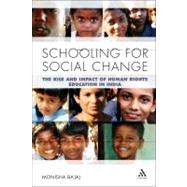
What is included with this book?
| List of Figures | p. x |
| Acknowledgments | p. xi |
| Abbreviations | p. xiv |
| Introduction | p. 1 |
| The Rise of Human Rights Education | p. 3 |
| Research Design | p. 6 |
| Data Sources and Data Collection Procedures | p. 7 |
| Researcher's Perspective | p. 9 |
| Summary of Chapters | p. 10 |
| Human Rights Education: Definitions, History, Ideologies | p. 15 |
| Structure of HRE | p. 16 |
| Normative Definitions of HRE | p. 16 |
| Bottom-Up Models | p. 18 |
| Global HRE Community | p. 19 |
| Location | p. 20 |
| Ideological Orientations and Outcomes of HRE | p. 21 |
| Human Rights Education for Global Citizenship | p. 24 |
| Human Rights Education for Coexistence | p. 25 |
| Human Rights Education for Transformative Action | p. 26 |
| Conclusion | p. 27 |
| Education and Human Rights in India: Policy, Pedagogy, and Practice | p. 28 |
| Indian Education: From Human Capital to Human Rights | p. 28 |
| Structure of Education | p. 31 |
| Uneven Development | p. 32 |
| Dalits in Schools and Society | p. 33 |
| Adivasi Communities | p. 34 |
| Education and Development Across Indian States | p. 35 |
| The Emergence and Landscape of Human Rights Education in India | p. 37 |
| Debates on Human Rights Education in India | p. 37 |
| National-Level Initiatives | p. 39 |
| The University Grants Commission (UGC) | p. 40 |
| National Council for Teacher Education (NCTE) | p. 43 |
| The National Council of Educational Research and Training (NCERT) | p. 47 |
| National Human Rights Commission (NHRC) | p. 49 |
| Linking Laws, Liberties, and Learning: The Institute of Human Rights Education | p. 53 |
| Strategy of Persuasive Pragmatism | p. 54 |
| Persuasive Pragmatism in Practice | p. 57 |
| Background of People's Watch and the Institute of Human Rights Education | p. 57 |
| Adoption and Expansion of HRE | p. 60 |
| Role of Advisory Boards | p. 60 |
| Government Officials as Sympathetic Bureaucrats | p. 63 |
| Role of Headmasters | p. 67 |
| Teachers | p. 70 |
| Conclusion | p. 75 |
| From "Time Pass" to Transformative Force: Human Rights Education for Marginalized Youth | p. 76 |
| Content and Pedagogy of HRE | p. 78 |
| Analyzing Impact | p. 79 |
| Individual Actions | p. 83 |
| Strategizing and Collective Action | p. 85 |
| Continuum of Impact | p. 90 |
| Building Solidarity and Coalitional Agency through Human Rights Education | p. 94 |
| Gender and Agency | p. 96 |
| Levels of Intervention | p. 98 |
| Human Rights and Charitable Action | p. 99 |
| Advocacy for More Equitable Conditions | p. 103 |
| HRE and Solidarity Action | p. 107 |
| Caste Discrimination: "You can keep your caste outside, don't bring it inside here" | p. 107 |
| Gender-Based Violence: "Why are you beating your wife like that?… This is a violation against the Domestic Violence Act" | p. 110 |
| Violations of Children's Rights: "Beating is the wrong way to treat students. You should use words rather than the stick to control students" | p. 112 |
| Conclusion | p. 114 |
| Teachers and Textbooks as Legitimating Forces for Human Rights Education | p. 116 |
| Perspectives on Teachers and HRE | p. 118 |
| Teachers and HRE in India | p. 120 |
| Institute of Human Rights Education (IHRE) | p. 120 |
| Teachers' Responses | p. 122 |
| The role of training | p. 122 |
| Personal changes | p. 123 |
| Community education | p. 125 |
| Intervening in abuse | p. 126 |
| Taking action and reporting abuse | p. 127 |
| Material assistance | p. 127 |
| Teachers as Legitimating Agents for Human Rights | p. 128 |
| Beyond the Classroom-Textbooks as Community Resources | p. 130 |
| Conclusion | p. 132 |
| Divergence and Decoupling: Indian Human Rights Education in Focus | p. 133 |
| Diverse Forms of Decoupling | p. 134 |
| Human Rights as Religious Morality | p. 136 |
| Human Rights as Hygiene and "Proper Dress" in Adivasi Communities | p. 140 |
| Human Rights as Left Politics | p. 143 |
| Forms of Resistance to Human Rights Education | p. 145 |
| Partial Acceptance and Internal Resistance | p. 145 |
| External Resistance | p. 147 |
| Conclusion | p. 149 |
| Implications and Concluding Thoughts | p. 151 |
| Implications for Global HRE Scholarship and Practice | p. 155 |
| Recommendations | p. 157 |
| Appendix A | p. 162 |
| Appendix B | p. 164 |
| Notes | p. 166 |
| Bibliography | p. 175 |
| Index | p. 187 |
| Table of Contents provided by Ingram. All Rights Reserved. |
The New copy of this book will include any supplemental materials advertised. Please check the title of the book to determine if it should include any access cards, study guides, lab manuals, CDs, etc.
The Used, Rental and eBook copies of this book are not guaranteed to include any supplemental materials. Typically, only the book itself is included. This is true even if the title states it includes any access cards, study guides, lab manuals, CDs, etc.